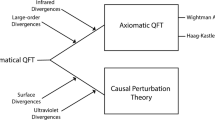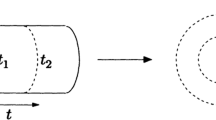Abstract
We solve the closed Schwinger–Dyson equation for the 2-point function of a tensor field theory with a quartic melonic interaction, in terms of Lambert’s W function, using a perturbative expansion and Lagrange–Bürmann resummation. Higher-point functions are then obtained recursively.



Similar content being viewed by others
Notes
Not to be confused with tensor fields living on a space-time such as in [4].
We computed the expansion up to order 9 in the coupling using Mathematica.
References
Ben Geloun, J., Rivasseau, V.: A renormalizable 4-dimensional tensor field theory. Commun. Math. Phys. 318, 69–109 (2013). https://doi.org/10.1007/s00220-012-1549-1
Ben Geloun, J., Rivasseau, V.: A renormalizable SYK-type tensor field theory. Ann. Henri Poincare 19(11), 3357–3395 (2018). https://doi.org/10.1007/s00023-018-0712-4
Benedetti, D., Carrozza, S., Gurau, R., Kolanowski, M.: The \(1/N\) expansion of the symmetric traceless and the antisymmetric tensor models in rank three. Commun. Math. Phys. 371, 55–97 (2017)
Benedetti, D., Gurau, R.: 2PI effective action for the SYK model and tensor field theories. JHEP 05, 156 (2018). https://doi.org/10.1007/JHEP05(2018)156
Bonzom, V., Dartois, S.: Blobbed topological recursion for the quartic melonic tensor model. J. Phys. A 51(32), 325201 (2018). https://doi.org/10.1088/1751-8121/aac8e7
Bonzom, V., Lionni, L., Tanasa, A.: Diagrammatics of a colored SYK model and of an SYK-like tensor model, leading and next-to-leading orders. J. Math. Phys. 58(5), 052301 (2017). https://doi.org/10.1063/1.4983562
Bürmann, H.: Essai de calcul fonctionnaire aux constantes ad-libitum. Mem. Inst. Nat. Sci Arts. Sci. Math. Phys. 2, 316–347 (1799)
Carrozza, S.: Tensorial Methods and Renormalization in Group Field Theories. Ph.D. thesis, Orsay, LPT (2014). https://doi.org/10.1007/978-3-319-05867-2
Carrozza, S.: Flowing in group field theory space: a review. SIGMA 12, 070 (2016). https://doi.org/10.3842/SIGMA.2016.070
Carrozza, S., Tanasa, A.: \(O(N)\) random tensor models. Lett. Math. Phys. 106(11), 1531–1559 (2016). https://doi.org/10.1007/s11005-016-0879-x
Corless, R.M., Gonnet, G.H., Hare, D.E.G., Jeffrey, D.J., Knuth, D.E.: On the LambertW function. Adv. Comput. Math. 5(1), 329–359 (1996). https://doi.org/10.1007/BF02124750
Delporte, N., Rivasseau, V.: The tensor track V: holographic tensors (2018). arXiv:1804.11101
Disertori, M., Gurau, R., Magnen, J., Rivasseau, V.: Vanishing of beta function of non commutative Phi**4(4) theory to all orders. Phys. Lett. B 649, 95–102 (2007). https://doi.org/10.1016/j.physletb.2007.04.007
Eichhorn, A., Koslowski, T., Lumma, J., Pereira, A.D.: Towards background independent quantum gravity with tensor models. Class. Quantum Gravity (2018). https://doi.org/10.1088/1361-6382/ab2545
Eichhorn, A., Koslowski, T., Pereira, A.D.: Status of background-independent coarse-graining in tensor models for quantum gravity. Universe 5(2), 53 (2019). https://doi.org/10.3390/universe5020053
Graham, R.L., Knuth, D.E., Patashnik, O.: Concrete Mathematics: A Foundation for Computer Science, 2nd edn. Addison-Wesley Longman Publishing Co., Inc., Boston (1994)
Gross, D.J., Rosenhaus, V.: All point correlation functions in SYK. JHEP 12, 148 (2017). https://doi.org/10.1007/JHEP12(2017)148
Grosse, H., Wulkenhaar, R.: Self-dual noncommutative \(\phi ^4\)-theory in four dimensions is a non-perturbatively solvable and non-trivial quantum field theory. Commun. Math. Phys. 329, 1069–1130 (2014). https://doi.org/10.1007/s00220-014-1906-3
Gurau, R.: Colored group field theory. Commun. Math. Phys. 304, 69–93 (2011). https://doi.org/10.1007/s00220-011-1226-9
Gurau, R.: Random Tensors. Oxford University Press, Oxford (2017)
Gurau, R.: The complete \(1/N\) expansion of a SYK-like tensor model. Nucl. Phys. B 916, 386–401 (2017). https://doi.org/10.1016/j.nuclphysb.2017.01.015
Kitaev, A.: A simple model of quantum holography. Talk at KITP. http://online.kitp.ucsb.edu/online/entangled15/kitaev/; http://online.kitp.ucsb.edu/online/entangled15/kitaev2/
Klebanov, I.R., Popov, F., Tarnopolsky, G.: TASI lectures on large \(N\) tensor models. In: Theoretical Advanced Study Institute in Elementary Particle Physics: Physics at the Fundamental Frontier (TASI 2017) Boulder, CO, USA, June 5–30, 2017 (2018)
Klebanov, I.R., Tarnopolsky, G.: Uncolored random tensors, melon diagrams, and the Sachdev–Ye–Kitaev models. Phys. Rev. D 95(4), 046004 (2017). https://doi.org/10.1103/PhysRevD.95.046004
Krajewski, T., Toriumi, R.: Exact renormalisation group equations and loop equations for tensor models. SIGMA 12, 068 (2016). https://doi.org/10.3842/SIGMA.2016.068
Lagrange, J.L.: Nouvelle méthode pour résoudre des équations littérales par le moyen de séries. Mém. Acad. R. Sci. B.-Lett. Berlin 24 (1770)
Maldacena, J., Stanford, D.: Remarks on the Sachdev–Ye–Kitaev model. Phys. Rev. D 94(10), 106002 (2016). https://doi.org/10.1103/PhysRevD.94.106002
Ousmane Samary, D., Pérez-Sánchez, C.I., Vignes-Tourneret, F., Wulkenhaar, R.: Correlation functions of a just renormalizable tensorial group field theory: the melonic approximation. Class. Quantum Grav. 32(17), 175012 (2015). https://doi.org/10.1088/0264-9381/32/17/175012
Panzer, E., Wulkenhaar, R.: Lambert-W solves the noncommutative \(\varPhi ^4\)-model (2018). arXiv:1807.02945
Pascalie, R., Pérez-Sánchez, C.I., Tanasa, A., Wulkenhaar, R.: On the large N limit of the Schwinger–Dyson equation of tensor field theory. J. Math. Phys. 60, 073502 (2018)
Pascalie, R., Sánchez, C.I.P., Wulkenhaar, R.: Correlation functions of coloured tensor models and their Schwinger–Dyson equations (2017). arXiv:1706.07358
Pérez-Sánchez, C.I.: Graph calculus and the disconnected-boundary Schwinger-Dyson equations in tensor field theory (2018)
Pérez-Sánchez, C.I.: The full Ward–Takahashi Identity for colored tensor models. Commun. Math. Phys. 358(2), 589–632 (2018). https://doi.org/10.1007/s00220-018-3103-2
Sachdev, S., Ye, J.: Gapless spin fluid ground state in a random, quantum Heisenberg magnet. Phys. Rev. Lett. 70, 3339 (1993). ArXiv:cond-mat/9212030
Samary, D.O.: Closed equations of the two-point functions for tensorial group field theory. Class. Quantum Grav. 31, 185005 (2014). https://doi.org/10.1088/0264-9381/31/18/185005
Witten, E.: An SYK-like model without disorder. J. Phys. A: Math. Theor. 52, 474002 (2016)
Acknowledgements
The author would like to thank Raimar Wulkenhaar for his guidance throughout this project, Adrian Tanasa for his advice and comments on the manuscript and Alexander Hock for helpful discussions.
Author information
Authors and Affiliations
Corresponding author
Additional information
Publisher's Note
Springer Nature remains neutral with regard to jurisdictional claims in published maps and institutional affiliations.
Funded by the Deutsche Forschungsgemeinschaft (DFG, German Research Foundation) under Germany’s Excellence Strategy EXC 2044–390685587, Mathematics Münster: Dynamics–Geometry–Structure and partially supported by the CNRS Infiniti ModTens Grant.
Appendix A: Recurrence relations
Appendix A: Recurrence relations
In this section, we will use the recursive equation (11) to determine recurrence relations on the numbers \(a_{n,k,m}\). We first perform the integration
where for \(p=1\) the sum on r does not appear. Plugging back the ansatz (19) in the recurrence relation (11) with \(c=1\) gives
The first term of (44) gives
where we sent \(k \rightarrow k+1\) and \(m \rightarrow m+1\) to get to the last line. The second term of (44) gives
Setting \(r=p+k\) in the line of the previous equation, let us rewrite the double sum as
Then, we send \(m \rightarrow m+1\) and rewrite double sum to get
Hence, sending \(p \rightarrow n-p\) and collecting the results, we get
The third term of (44) gives
The first term of Eq. (50) gives
by setting \(k=p-r\). Then, by setting \(l=n-1-k\) and rewriting the sums, we get
Then, we set \(k = l-r+1\) and obtain
The second term of (50) gives, by rewriting the sums,
First by setting \(q=k+r\) and by several rewriting of the sums, we get
where we send \(l \rightarrow l+1\) in the last line.
Now, collecting all the results, we obtain recurrence relations on \(a_{n,k,m}\):
Rewriting these equations gives explicit relations on Stirling numbers of the first kind, harmonic numbers and binomial coefficients. Indeed, from Eq. (60), we recover
which corresponds to equation (6.21) in [16].
Setting \(l=n-2-r \), \(k = n-m-1 \) and sending \(n-3 \rightarrow n\), Eq. (59) gives
Sending \(r \rightarrow k-l\) and in the last term \(l \rightarrow r\) of Eq. (61), we get
for \(k \in \llbracket 2,n-3 \rrbracket \) and \(m \in \llbracket 2,k \rrbracket \).
Rights and permissions
About this article
Cite this article
Pascalie, R. A solvable tensor field theory. Lett Math Phys 110, 925–943 (2020). https://doi.org/10.1007/s11005-019-01245-0
Received:
Revised:
Accepted:
Published:
Issue Date:
DOI: https://doi.org/10.1007/s11005-019-01245-0




